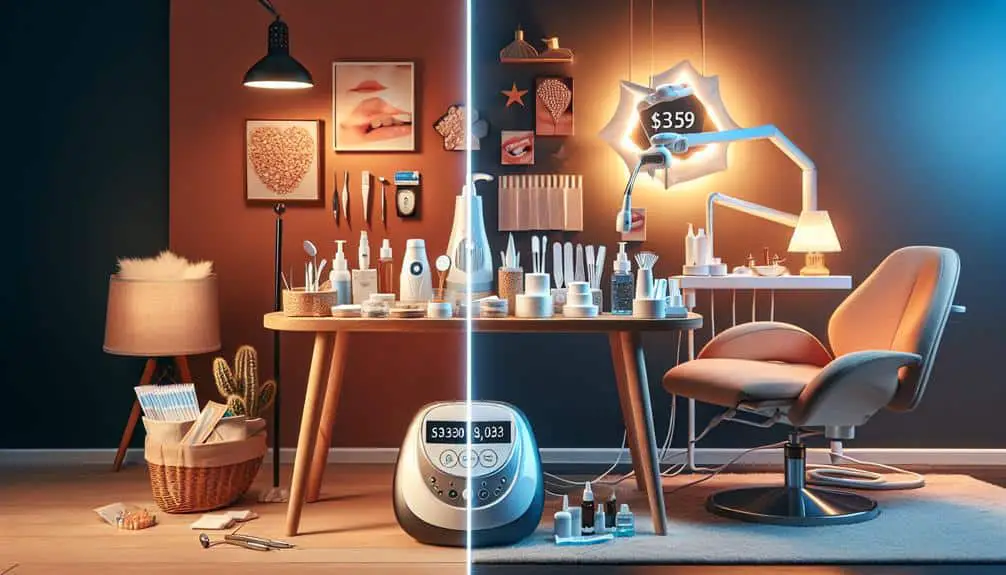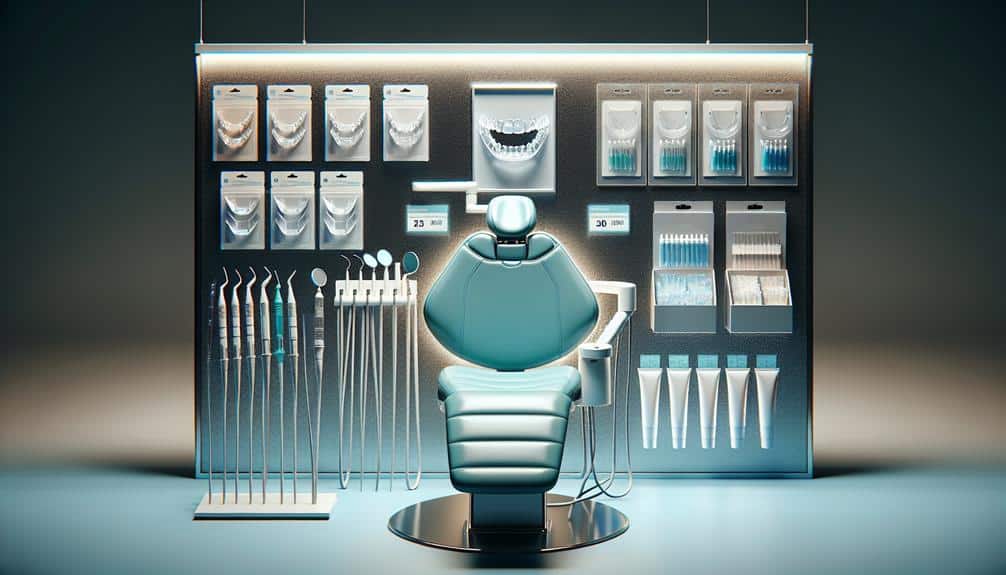When deciding between at-home and in-office teeth whitening, consider key cost aspects. Home kits typically range from $20 to $50, offering affordability but varying results based on usage. In-office treatments come with a higher upfront cost but provide immediate, potent results that endure. Factors like the type and quantity of whitening agents, additional supplies, and long-term benefits all influence the overall expense. Make an informed choice based on budget, desired outcome, and time commitment – each option has distinct advantages worth exploring further.
Key Points
- At-home whitening kits cost between $20 to $50, while in-office treatments may have a higher initial cost.
- DIY methods offer affordability upfront, but professional whitening provides quicker and more potent results.
- Long-term savings potential with in-office whitening due to its effectiveness and lasting results.
- In-office treatments guarantee immediate noticeable results in just one session.
- Factors like whitening agents, quantity, and additional accessories impact the overall cost of both methods.
At-Home Whitening Cost Breakdown
When contemplating the cost breakdown of at-home whitening treatments, it's crucial to factor in the price of the whitening kit, additional supplies, and any potential follow-up purchases. DIY methods for teeth whitening have gained popularity due to their convenience and potential cost savings compared to professional treatments. These kits typically range from $20 to $50, making them an attractive option for those looking to brighten their smile without breaking the bank.
The efficacy of at-home whitening kits varies depending on the brand and individual compliance with the instructions. While these DIY methods can provide noticeable results, they may not be as potent as in-office treatments. However, the long-term savings associated with at-home kits make them a practical choice for maintaining a whiter smile.
In addition to the initial kit cost, it's essential to consider the need for additional supplies like whitening strips or gels for ongoing treatment. Despite their lower upfront cost, at-home whitening treatments may require more frequent application to achieve desired results compared to in-office procedures.
In-Office Whitening Price Analysis
For those seeking professional teeth whitening services, understanding the pricing structure for in-office treatments is essential to make an informed decision about enhancing your smile. When considering in-office whitening, here are three key points to keep in mind:
- Treatment Effectiveness: In-office whitening treatments are highly effective due to the use of professional-grade bleaching agents and specialized equipment that can deliver significant results in just one session. The concentration of whitening agents used in these treatments is higher than what's typically found in at-home kits, leading to more noticeable and longer-lasting results.
- Time Commitment: In-office whitening procedures usually take about 60 to 90 minutes per session, providing a quick way to achieve a brighter smile without the need for multiple applications over several days or weeks. The immediate results can be particularly appealing for those with busy schedules or special events coming up.
- Cost Analysis: While the initial cost of in-office whitening may be higher than at-home alternatives, the efficiency and effectiveness of professional treatments can lead to a more cost-effective solution in the long run, especially when considering the time saved and the superior results obtained.
Factors Affecting At-Home Whitening Expenses
Factors impacting the expenses for at-home teeth whitening kits include the type of whitening agent used, the quantity of product provided, and the inclusion of additional accessories in the kit. DIY options often offer a range of whitening agents such as hydrogen peroxide or carbamide peroxide, which can affect the price due to their varying effectiveness and cost. The concentration of the whitening agent also plays a role in determining the overall price, with higher concentrations generally being more expensive but potentially delivering quicker results.
When considering at-home whitening expenses, the quantity of product provided in the kit is vital. Larger quantities may come at a higher cost initially but could be more cost-effective in the long run if multiple applications are needed for desired results. Additionally, the inclusion of accessories like trays, LED lights, or desensitizing gels can add to the overall cost but may enhance the whitening experience and results. Product quality is another factor influencing expenses, as higher-quality ingredients and manufacturing processes typically come at a higher price point but may offer better and more consistent results.
Calculating In-Office Whitening Costs
To determine the cost of in-office teeth whitening, consider the factors that contribute to the overall price and the services included in the treatment package. When calculating the expenses for an in-office procedure, keep in mind the following:
- Professional Expertise: In-office whitening is performed by dental professionals who have the knowledge and experience to guarantee the procedure is done correctly, leading to professional results.
- Quality of Materials: In-office whitening treatments often use higher quality whitening agents and advanced equipment, which can contribute to the cost but also provide more effective and long-lasting results.
- Comprehensive Care: In addition to the whitening procedure itself, the cost of in-office whitening may include aftercare instructions, follow-up appointments, and maintenance products, offering long-term benefits beyond just the initial treatment.
Considering these factors can help you appreciate the value of in-office whitening as a cost-effective solution that provides professional results and long-term benefits for your oral health and aesthetics.
Budgeting: Home Vs. Professional Whitening
When comparing the expenses of teeth whitening, it's crucial to take into account the financial aspects of at-home methods versus professional in-office treatments. DIY options for teeth whitening typically include over-the-counter whitening strips, trays, or toothpaste. These products are generally more budget-friendly upfront compared to in-office treatments.
However, it's vital to ponder the savings potential in the long run. Professional whitening treatments done in the dentist's office may have a higher initial cost, but they often provide more immediate and noticeable results. Additionally, in-office whitening treatments are usually more potent and can achieve whiter teeth in a shorter amount of time compared to at-home alternatives.
While at-home whitening may seem more cost-effective initially, professional whitening could be more efficient, potentially requiring fewer treatments to achieve desired results. Ultimately, the decision between at-home and professional whitening methods should take into account both the upfront costs and the long-term savings potential.
Frequently Asked Questions
Are There Any Long-Term Risks or Side Effects Associated With At-Home Teeth Whitening Compared to In-Office Treatments?
When whitening teeth at home, safety concerns include potential damage to enamel and increased tooth sensitivity. In-office treatments are typically safer due to professional supervision. Long-term risks may vary, but in general, at-home methods may pose more risks compared to in-office treatments.
How Do the Results of At-Home Teeth Whitening Compare to In-Office Treatments in Terms of Effectiveness and Longevity?
When comparing at-home teeth whitening to in-office treatments, effectiveness levels vary. In-office procedures often yield quicker and more dramatic results. However, longevity can differ, with at-home methods possibly requiring more frequent maintenance, impacting cost effectiveness and ongoing expenses.
Can At-Home Teeth Whitening Kits Cause Damage to Tooth Enamel or Gums if Used Incorrectly?
When using at-home teeth whitening kits, be cautious of potential risks like enamel damage or gum irritation if not used correctly. Proper technique, following instructions, and avoiding overuse can help prevent these issues.
Are There Any Differences in the Types of Whitening Agents Used in At-Home Products Versus Those Used in Professional Treatments?
When considering the types of whitening agents, at-home products typically contain lower concentrations of active ingredients compared to professional treatments. Safety concerns arise from improper usage of strong agents in-office, while at-home kits require diligent application for effective results.
How Do the Costs of Maintenance and Touch-Up Treatments Differ Between At-Home and In-Office Teeth Whitening Options?
To achieve best results, consider the frequency and costs of maintenance and touch-up treatments when comparing at-home and in-office teeth whitening. You'll find potential cost savings with at-home options but may need more frequent treatments for lasting brightness.




